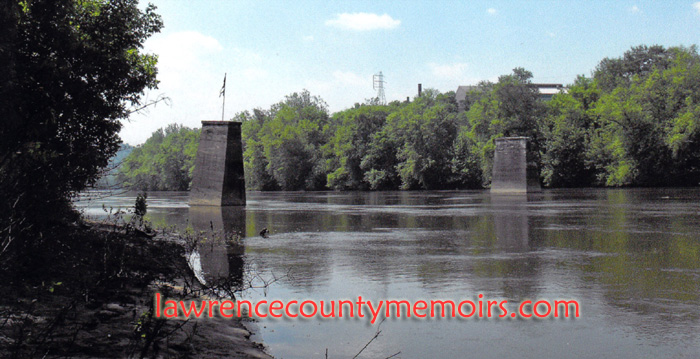In the late 1880’s, Henry Waters Hartman, a wealthy industrialist and steel man centered in Beaver Falls, Pennsylvania, envisioned the establishment of a manufacturing center and town on a plateau along the Connoquenessing Creek near the southeast corner of Lawrence County. Hartman resurrected a dormant land venture outfit as the Pittsburg Company, set about purchasing large plots of property in the area, and named the new settlement Ellwood (soon expanded to Ellwood City). A big boast to his venture was the fact that plans were being formulated by the Pittsburgh & Western Railroad (P&W) – soon under the control of the powerful Baltimore & Ohio Railroad (B&O) – to run a new route through the same area.
Hartman made plans in 1891-92 to build an electric streetcar system throughout Ellwood City and the surrounding areas. Towards that end he started an electric company, surveyed the proposed route, purchased equipment and supplies, and bought a single trolley car. Hartman soon abandoned that effort and relied on the steam railroads as two so-called “shortlines” ran through Ellwood City. Those were the Beaver & Ellwood Shortline, which was later joined with the main line of the Pennsylvania & Lake Erie Railroad (P&LE) on west side of the Beaver River, and the B&O Shortline, which cut though the heart of Ellwood City en route to New Castle and beyond.
For almost a decade Hartman was the town’s leading citizen and his Pittsburg Company owned many businesses and industries in Ellwood City. The company also donated land for several schools and churches. Hartman’s power and influence gradually declined by 1900, as Ralph C. Stiefel, the Swiss-born powerful head of the seamless tube industry, and others gained in local prominence. By 1900 Hartman sold off many of his assets in Ellwood City and soon began making trips out to Colorado, where he got involved in railway and real estate interests. He continued to reside in Ellwood City for the time being.
Throughout the years Hartman never lost his desire to establish a streetcar system in Ellwood City. In about 1908 he made plans to build such a line to connect to nearby Beaver Falls – where it could join existing lines already connected to distant Pittsburgh. Those plans eventually came into bitter competition with three other groups, including the Pittsburgh, Harmony, Butler, and New Castle Railway (known as the Harmony Line) that had opened an interurban streetcar line between Pittsburgh to New Castle in July 1908. Up for grabs was the awarding of the valuable right-of-way through the heart of Ellwood City.
As the Ellwood City Council debated the issue beginning about 1909 Hartman went ahead with his plans and secured right-of-ways from the western reaches of Ellwood City to Beaver Falls. He also started work on the biggest obstacle to such a route – building a bridge across the formidable Beaver River near West Ellwood Junction (the railroad junction near Koppel). The large bridge would carry the streetcars as well as public vehicle traffic and construction of the two middle piers commenced by early 1910. Work on the bridge foundation slowly progressed with various delays, such as quicksand issues and financial concerns, over the next two years.
In November 1912 Hartman got some bad news. The Ellwood City Council had decided in favor of awarding the streetcar franchise – and the right-of-ways through the heart of the Ellwood City – to the Harmony Line. A dejected and disillusioned Hartman immediately halted all work on his proposed route and permanantly moved out to Colorado. Hartman, the man who founded Ellwood City and had done so much for the settlement, must have felt bitter at the politicians who forced him out. It’s a shame how it all ended. Hartman died in Denver in September 1913 at the age of sixty-two. He remains were returned home for burial in Hollidaysburg, Pennsylvania.
The Harmony Line, needing its own bridge over the Beaver River, explored several ideas including purchasing Hartman’s completed piers or buying the old P&LE Railroad Bridge a short distance to the north. After examining Hartman’s piers and deciding they were not of high quality construction, the Harmony officials opted to start work on a completely new span at the same general location. Their bridge (the modern-day Koppel Bridge) was completed in November 1914 and opened up long-awaited streetcar service between Ellwood City and Beaver Falls.
These days if you walk across the Koppel Bridge and look off the southern side you can still see what remains of Hartman’s streetcar efforts: two century-old concrete piers standing defiantly in the middle of the Beaver River.
To read an article about the resumption of construction on the bridge piers in late 1910 click on: WORK RESUMES ARTICLE and WORKING ON PIER ARTICLE. To read a short article about work on the proposed bridge in October 1911 click on: PIERS ARE UP ARTICLE.
 A view of what remains of Hartman’s proposed bridge across the Beaver River. IPSCO Tubular Products Corp., formerly Koppel Steel, is visible in the background. (Jul 2011) |
 The two piers, constructed in 1910, stand almost as monuments to Hartman’s unfinished business in Ellwood City. (c2008) Full Size |
 Another view of the two piers that were constructed during 1910. Just off camera to the right is the Koppel Bridge, originally built by the Harmony Line back in 1912-1914. (Jul 2011) |






Comments
preston #
hm the founder of ellwood gets the ol screwjob not suprised knowing how the people of ellwood are
Comment